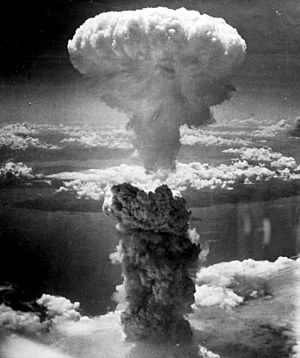Period 7 element facts for kids
Imagine the periodic table as a giant chart of all the known elements. A period 7 element is simply any element found in the seventh row, or period, of this table. This row is very long, containing 32 different elements. It starts with Francium and goes all the way to Oganesson (which used to be called Ununoctium). A special group of elements called the actinides are also part of this period.
Properties of Period 7 Elements
All the elements in Period 7 are radioactive. This means their atoms are unstable and release energy as they change into other elements.
This period includes the actinides. The heaviest element found naturally on Earth, plutonium, is an actinide. Other elements in this period, especially those after plutonium, are not found naturally. Scientists have to make them in special laboratories.
While some of these elements, like plutonium, can be made in larger amounts, most are extremely rare. Often, only tiny amounts (like micrograms) have ever been created. The elements at the very end of the period, called transactinides, are even rarer. Scientists have only managed to identify a few atoms of these at a time.
Because many of these elements are so rare, we don't know as much about their exact properties compared to other elements. However, we do know that elements like francium and radium act like typical elements in their groups. But the actinides are a bit different. They show a wider range of behaviors and ways they can combine with other elements.
These unique behaviors happen because of special effects inside their atoms. Their very large atomic nuclei have a strong positive charge. This causes their electrons to behave in unusual ways, making the elements act differently from what you might expect.
Elements in Period 7
| Chemical element | Chemical series | Electron configuration | Occurrence | ||
|---|---|---|---|---|---|
| 87 | Fr | Francium | Alkali metal | [Rn] 7s1 | From decay |
| 88 | Ra | Radium | Alkaline earth metal | [Rn] 7s2 | From decay |
| 89 | Ac | Actinium | Actinide | [Rn] 6d1 7s2 | From decay |
| 90 | Th | Thorium | Actinide | [Rn] 6d2 7s2 (*) | Primordial |
| 91 | Pa | Protactinium | Actinide | [Rn] 5f2 6d1 7s2 | From decay |
| 92 | U | Uranium | Actinide | [Rn] 5f3 6d1 7s2 | Primordial |
| 93 | Np | Neptunium | Actinide | [Rn] 5f4 6d1 7s2 | From decay |
| 94 | Pu | Plutonium | Actinide | [Rn] 5f6 7s2 (*) | From decay |
| 95 | Am | Americium | Actinide | [Rn] 5f7 7s2 (*) | Synthetic |
| 96 | Cm | Curium | Actinide | [Rn] 5f7 6d1 7s2 | Synthetic |
| 97 | Bk | Berkelium | Actinide | [Rn] 5f9 7s2 (*) | Synthetic |
| 98 | Cf | Californium | Actinide | [Rn] 5f10 7s2 (*) | Synthetic |
| 99 | Es | Einsteinium | Actinide | [Rn] 5f11 7s2 (*) | Synthetic |
| 100 | Fm | Fermium | Actinide | [Rn] 5f12 7s2 (*) | Synthetic |
| 101 | Md | Mendelevium | Actinide | [Rn] 5f13 7s2 (*) | Synthetic |
| 102 | No | Nobelium | Actinide | [Rn] 5f14 7s2 (*) | Synthetic |
| 103 | Lr | Lawrencium | Actinide | [Rn] 5f14 7s2 7p1 (*) | Synthetic |
| 104 | Rf | Rutherfordium | Transition metal | [Rn] 5f14 6d2 7s2 | Synthetic |
| 105 | Db | Dubnium | Transition metal | [Rn] 5f14 6d3 7s2 | Synthetic |
| 106 | Sg | Seaborgium | Transition metal | [Rn] 5f14 6d4 7s2 | Synthetic |
| 107 | Bh | Bohrium | Transition metal | [Rn] 5f14 6d5 7s2 | Synthetic |
| 108 | Hs | Hassium | Transition metal | [Rn] 5f14 6d6 7s2 | Synthetic |
| 109 | Mt | Meitnerium | Transition metal (?) | [Rn] 5f14 6d7 7s2 (?) | Synthetic |
| 110 | Ds | Darmstadtium | Transition metal (?) | [Rn] 5f14 6d8 7s2 (?) | Synthetic |
| 111 | Rg | Roentgenium | Transition metal (?) | [Rn] 5f14 6d9 7s2 (?) | Synthetic |
| 112 | Cn | Copernicium | Post-transition metal | [Rn] 5f14 6d10 7s2 (?) | Synthetic |
| 113 | Nh | Nihonium | Post-transition metal (?) | [Rn] 5f14 6d10 7s2 7p1 (?) | Synthetic |
| 114 | Fl | Flerovium | Post-transition metal (?) | [Rn] 5f14 6d10 7s2 7p2 (?) | Synthetic |
| 115 | Mc | Moscovium | Post-transition metal (?) | [Rn] 5f14 6d10 7s2 7p3 (?) | Synthetic |
| 116 | Lv | Livermorium | Post-transition metal (?) | [Rn] 5f14 6d10 7s2 7p4 (?) | Synthetic |
| 117 | Ts | Tennessine | Post-transition metal (?) | [Rn] 5f14 6d10 7s2 7p5 (?) | Synthetic |
| 118 | Og | Oganesson | Noble gas (?) | [Rn] 5f14 6d10 7s2 7p6 (?) | Synthetic |
See also
 In Spanish: Elementos del periodo 7 para niños
In Spanish: Elementos del periodo 7 para niños


